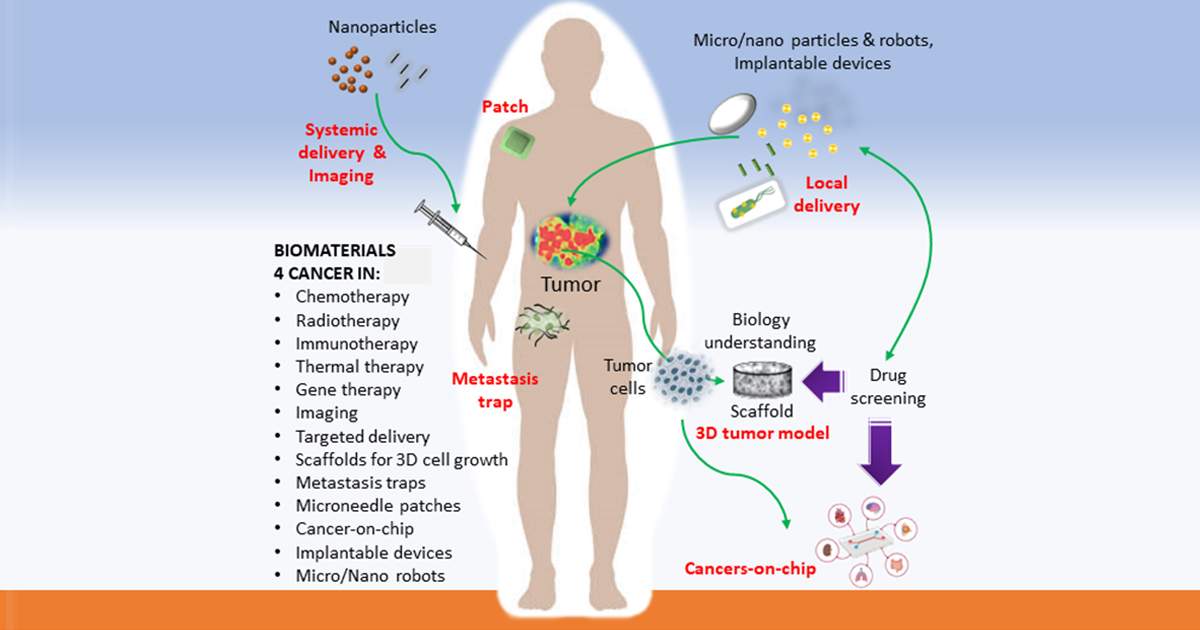Feature Papers in Biomaterials for Cancer Therapies
A special issue of Journal of Functional Biomaterials (ISSN 2079-4983). This special issue belongs to the section "Biomaterials for Cancer Therapies".
Deadline for manuscript submissions: closed (20 April 2024) | Viewed by 5326

Special Issue Editor
2. Department of Civil and Environmental Engineering, Massachusetts Institute of Technology (MIT), Cambridge, MA 02139, USA
Interests: electrospinning; biomaterials; biomedical polymers; piezoelectric materials; smart materials; tissue engineering; advanced in vitro models
Special Issues, Collections and Topics in MDPI journals
Special Issue Information
Dear Colleagues,
Despite the advancement in current treatments for many malignant neoplasms, the prognosis for several cancers is still largely unfavorable. A main reason is that tumor biology and the tumor microenvironment are not fully mastered; thus, therapies cannot be pinpoint and effective. Not only new drugs have to be developed and tested, but also precise and personalized administration routes have to be assessed, along with understanding and correcting the genetic and epigenetic multifactorial aspects of cancer.
This Special Issue aims to collect and highlight the special and multifold role of biomaterials in ameliorating cancer therapies, thus unveiling novel opportunities to treat and study this disease. Biomaterials offer an infinitely versatile platform of smart tools to be applied in such a complex pathologic scenario, including, but not limited to, biomaterial-based approaches (i.e., nano/micro particles and robots) for systemic or targeted delivery of single or combined chemo/bioactive factors, for imaging enhancement, and thermal ablation, as well as biomaterial-based percutaneous or implantable devices for the local administration of chemotherapy, for metastasis trap, or the induction of cancer-immunotherapy. In addition, the promising application of biomaterials to study cancers encompasses hydrogels and polymeric scaffolds to tissue engineer complex 3D in vitro models representative of the tumor microenvironment, and also supports cancer-on-chip technology to investigate drug performance in a personalized fashion. Owing to their versatile and easily tunable properties, biomaterials hold promise for the treatment and study of neoplasms, thereby largely contributing to the societal challenge of cancer. Review papers, original contributions and perspective articles facing any aspect of biomaterials (biologic synthetic, bioartificial or composite), also a part of a device, on this topic are greatly welcome for this Special Issue.
Dr. Serena Danti
Guest Editor
Manuscript Submission Information
Manuscripts should be submitted online at www.mdpi.com by registering and logging in to this website. Once you are registered, click here to go to the submission form. Manuscripts can be submitted until the deadline. All submissions that pass pre-check are peer-reviewed. Accepted papers will be published continuously in the journal (as soon as accepted) and will be listed together on the special issue website. Research articles, review articles as well as short communications are invited. For planned papers, a title and short abstract (about 100 words) can be sent to the Editorial Office for announcement on this website.
Submitted manuscripts should not have been published previously, nor be under consideration for publication elsewhere (except conference proceedings papers). All manuscripts are thoroughly refereed through a single-blind peer-review process. A guide for authors and other relevant information for submission of manuscripts is available on the Instructions for Authors page. Journal of Functional Biomaterials is an international peer-reviewed open access monthly journal published by MDPI.
Please visit the Instructions for Authors page before submitting a manuscript. The Article Processing Charge (APC) for publication in this open access journal is 2700 CHF (Swiss Francs). Submitted papers should be well formatted and use good English. Authors may use MDPI's English editing service prior to publication or during author revisions.
Keywords
- biomaterials applications to fight cancers






